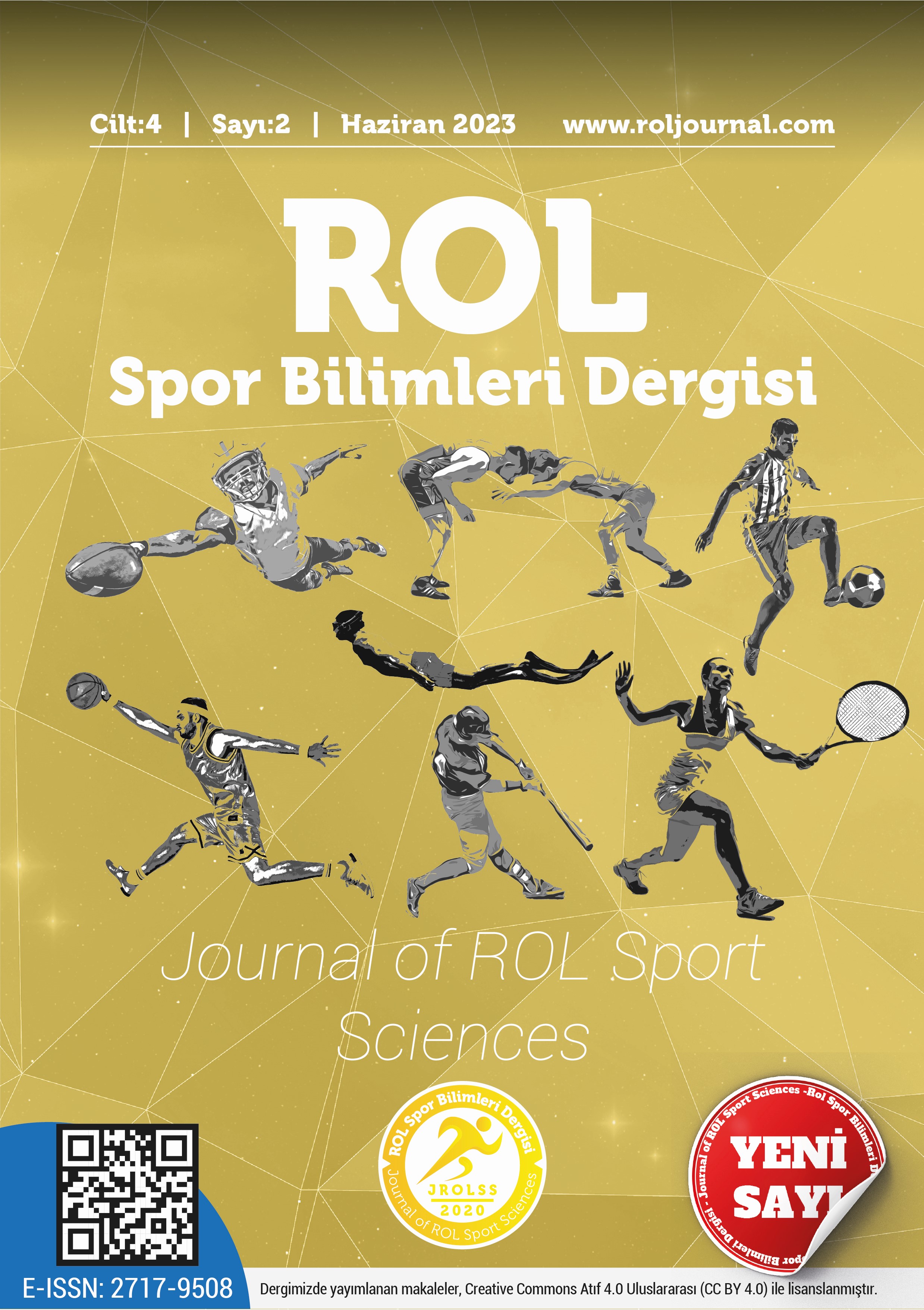Examination of emotional labor and burnout levels of physical education teachers and other branch teachers in terms of some variables
DOI:
https://doi.org/10.5281/zenodo.8037502Keywords:
Burnout, emotional labor, physical education teacherAbstract
In this study, it was aimed to examine the relationships between teachers' emotional labor tendencies and their burnout, and to determine the differentiation status of physical education and other branch teachers' views on variables. The sample group of the study, which was carried out in relational screening model, consisted of 338 teachers. The data of the research were obtained by using the "Emotional Labor Scale" and the "Maslach Burnout Inventory". The arithmetic mean and standard deviation values were used in descriptive statistics regarding the variables, and the independent samples t-Test was used to determine the differentiation between groups. Correlation analysis was used to determine the relationship between the variables, and path analysis was used to determine to what extent the independent variables predicted the dependent variable. As another result of the study, it was concluded that physical education teachers' superficial role-playing tendencies and emotional burnout were lower than other branch teachers, and that natural emotions tendencies and personal achievement perceptions were higher than other branch teachers. According to the results of the path analysis, it was determined that natural emotions and deep acting tendency predicted all dimensions of burnout, while surface acting tendency predicted emotional burnout only. Although it does not mean causality, it was found that as natural emotions and the tendency to play deeply increase, personal success increases significantly, while depersonalization and emotional exhaustion decrease.
References
Aydoğan, S. S., & Bostancı, A. B. (2021). Öğretmenlerin duygusal emek gösterimleri ile psikolojik sözleşmeye uyma düzeyleri arasındaki ilişki. OPUS International Journal of Society Researches, 17(36), 2637-2674.
Basım, H. N., & Begenirbaş, M. (2012). Çalışma yaşamında duygusal emek: Bir ölçek uyarlama çalışması. Yönetim ve Ekonomi: Celal Bayar Üniversitesi İktisadi ve İdari Bilimler Fakültesi Dergisi, 19(1), 77-90.
Brown, E. L. (2011). Emotion matters, Explorıng The Emotıonal Labor Of Teaching.
Büyüköztürk, Ş. (2017). Sosyal bilimler için veri analizi el kitabı, Pegem Akademi.
Cemaloğlu, N., & Şahin, E. D., (2007). Öğretmenlerin mesleki tükenmişlik düzeylerinin farklı değişkenlere göre incelenmesi. Kastamonu Eğitim Dergisi, 15(2), 463-484.
Cihan, B. B. (2011). Farklı illerde çalışan ilköğretim okullarında görevli beden eğitimi öğretmenlerinin, mesleki tükenmişlik düzeylerinin incelenmesi ve karşılaştırılması [Yayınlanmamış yüksek lisans tezi, Gazi Üniversitesi]. Eğitim Bilimleri Enstitüsü.
Çelik, H. E., & Yılmaz, V. (2014). LISREL 9.1 ile yapısal eşitlik modellemesi, Anı Yayıncılık.
Çokluk, Ö., Şekercioğlu, G., & Büyüköztürk, Ş. (2014). Sosyal bilimler içinçok değişkenli istatistik SPSS ve LISREL uygulamaları, Pegem Akademi Yayınları.
Dıefendorff, J. M., Croyle, M. H., & Grosserand, R. H. (2005), “The Dimensionality and antecedents of emotinal labor strategies”. Journal of Vocational Behavior, 66, 339-357.
Erkul, A. (2014). Meslek lisesi öğretmenlerinin mesleki tükenmişlik düzeyi [Yüksek lisans tezi, Bahçeşehir Üniversitesi]. Eğitim Bilimleri Enstitüsü.
Hargreaves, A. (1998). The emotional practice of teaching. Teaching and Teacher Education, 14(8), 853-854.
İnce, N. B., & Şahin, A. E. (2015). Maslach tükenmişlik envanteri-eğitimci formu’nu türkçe’ye uyarlama çalışması. Eğitimde ve Psikolojide Ölçme ve Değerlendirme Dergisi, 6(2), 385-399.
Karasar, N. (2012). Bilimsel araştırma yöntemleri, Nobel Yayınları.
Kart, E. (2010). Nitelikli işgücünün küresel trajedisi, Kavim Kitap.
Lupton, D. (2002). Duygusal yaşantı, Ayrıntı Yayınları.
Mann, S. (2007). Expectations of emotional display in the workplace. Leadership & Organizational development Journal, 28(6), 552-570.
Maslach, C. (1993). Burnout: A multidimensional perspective, Taylor and Fracis.
Maslach, C., & Jackson, S. E. (1981). The measurement of experienced burnout. Journal of Organizational Behavior, 2(2), 99-113.
Moran, C. (2018). İlköğretim kurumlarındaki öğretmenlerin duygusal emek davranışları ile yaşam doyum düzeyleri arasındaki ilişki [Yayınlanmamış yüksek lisans tezi, Çanakkale Onsekiz Mart Üniversitesi]. Çanakkale.
Özyılmaz, M. D., & Türkoğlu, N. (2019). Psikolojik sermayenin duygusal emek üzerine etkisi: Hizmet sektöründe bir araştırma. İşletme Araştırmaları Dergisi, 11(1), 173-188.
Polatkan, N. N. (2016). Ortaokul öğretmenlerinin duygusal emek davranışları ile iş doyumları arasındaki ilişki [Yüksek lisans tezi, Adnan Menderes Üniversitesi]. Sosyal Bilimler Enstitüsü.
Robbins, S. P. (2005). Essentials of organizational behavior, Upper Saddle River.
Seçer, Ş. (2005). Çalışma yaşamında duygular ve duygusal emek: sosyoloji, psikoloji ve örgüt teorisi açısından bir değerlendirme, İÜ Yayınevi.
Sümer, N. (2000). Yapısal eşitlik modelleri. Türk Psikoloji Yazıları, 3(6), 49-74.
Şimşek, Ö. F. (2007). Yapısal eşitlik modellemesine giriş, Ekinoks Yayınları.
Tabachnick, B. G., & Fidel, L. S. (2001). Using multivariate statistics, Allyn & Bacon.
Tuna, M. (2010). Beden eğitimi öğretmenlerinin tükenmişlik düzeyleri (Ankara İli Örneği) [Yüksek lisans tezi, Gazi Üniversitesi]. Sağlık Bilimleri Enstitüsü.
Ye, M. L., & Chen, Y. (2015). A literature review on teachers’ emotional labor. Creative Education, (6), 2232-2240.
Zheng, X., Yin, H., & Wang, M. (2018). Leading with teachers’ emotional labour: Relationships between leadership practices, emotional labour strategies and efficacy in China. Teachers and Teaching, 24(8), 965-979.
Downloads
Published
How to Cite
Issue
Section
License
Copyright (c) 2023 Journal of ROL Sport Sciences

This work is licensed under a Creative Commons Attribution 4.0 International License.

